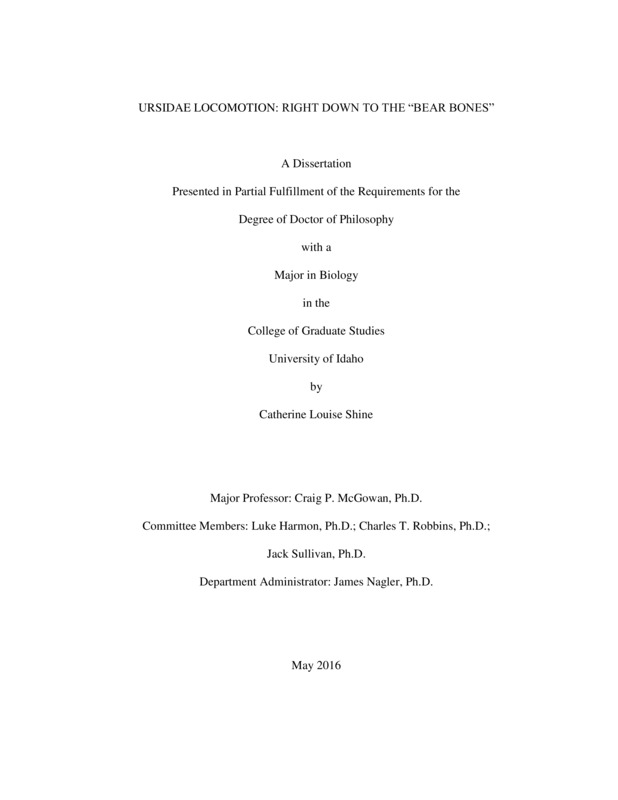URSIDAE LOCOMOTION: RIGHT DOWN TO THE “BEAR BONES”
Shine, Catherine L.. (2016). URSIDAE LOCOMOTION: RIGHT DOWN TO THE “BEAR BONES”. Theses and Dissertations Collection, University of Idaho Library Digital Collections. https://www.lib.uidaho.edu/digital/etd/items/shine_idaho_0089e_10943.html
- Title:
- URSIDAE LOCOMOTION: RIGHT DOWN TO THE “BEAR BONES”
- Author:
- Shine, Catherine L.
- Date:
- 2016
- Embargo Remove Date:
- 2018-07-08
- Program:
- Biology
- Subject Category:
- Biology; Biomechanics
- Abstract:
-
The plantigrade posture refers to species that have their entire foot, from heel to toes, on the ground. The Order Carnivora contains terrestrial families of both digitigrade (stand on their toes) and plantigrade species, and includes a wide representation of locomotor behaviours.
Bears (family Ursidae) are the only group of large plantigrade species in Carnivora. This makes ursids a unique family as they are relatively distinct from other mammals. Ursidae morphology is at the extreme plantigrade end of the posture spectrum, therefore representative of plantigrade animals, despite their significantly larger size than other carnivoran species. Within Ursidae there are eight extant bear species; these species range in size, diet, and locomotor behaviour.
There have been many previous studies of the relationship between morphology and locomotor behaviour in Carnivora, all of which have included both digitigrade and plantigrade species. Plantigrade species, particularly bears, are often noted as outliers in these studies. However, it’s possible that the morphological differences related to posture are confounding the results.
The aims of this dissertation were to characterise the locomotion of a representative plantigrade carnivoran (grizzly bears; Ursus arctos horribilis), and to determine if a model using bone morphology of only plantigrade species could increase accuracy of estimating locomotor behaviour in extinct plantigrade species.
The first chapter of my dissertation is a detailed description of the design, construction, and calibration of a force plate. This force plate was custom built to be used with grizzly bears, although it is suitable for both smaller and larger animals. Chapters 2 and 3 are analyses of grizzly bear locomotion. This includes a description of the gaits used and the ground reaction forces produced by the bears, as well as a more detailed analysis of the forelimb joint dynamics across speed. The fourth chapter of my dissertation is a morphometric analysis of forelimb bones from 44 extant species of plantigrade carnivorans, plus specimens from two extinct genera.
Overall this dissertation is a comprehensive view of the locomotion of a representative plantigrade species, incorporated into an evolutionary framework by bone shape analysis of several other plantigrade families.
- Description:
- doctoral, Ph.D., Biology -- University of Idaho - College of Graduate Studies, 2016
- Major Professor:
- McGowan, Craig P
- Committee:
- Robbins, Charles T; Harmon, Luke; Sullivan, Jack
- Defense Date:
- 2016
- Identifier:
- Shine_idaho_0089E_10943
- Type:
- Text
- Format Original:
- Format:
- application/pdf
- Rights:
- In Copyright - Educational Use Permitted. For more information, please contact University of Idaho Library Special Collections and Archives Department at libspec@uidaho.edu.
- Standardized Rights:
- http://rightsstatements.org/vocab/InC-EDU/1.0/

